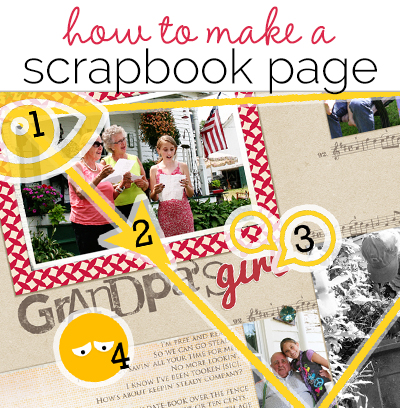
by Debbie Hodge
You’ve gathered photos and checked out scrapbooking ideas to find out how to make a scrapbook page. And, yet, you’re still not sure how to start. You can’t find step-by-step instructions or, if you do find them, they don’t really fit with your photos and story.
What you need are guidelines for putting together the parts of a scrapbook page. You’re probably already using related approaches when you decorate your home or pull items from the closet for a special outing.
The primary work of making a scrapbook page is to combine images and words within space (the page!) to communicate and evoke emotion. Below are the tools and rules–the guidelines, if you will–that you need to do this.[divider_flat]
these are the parts of a scrapbook page
A scrapbook page has five key parts:
 photos
photos- journaling
- title
- embellishments
- canvas
Not every page has every part—but most pages have most parts.
Understand what these parts are and the work they do on a scrapbook page, and you’ll have touchpoints for choosing and cropping photos, deciding on what else to include, as well as how to arrange everything. (Learn these steps in our free design classes by clicking on the banner at the top of the page.)
[divider_flat]
use design principles to choose and place page parts
Use basic design tools to guide your placement of “page parts” on the canvas. These design tools are also useful for other tasks, from making a poster or invitation to decorating a mantel or choosing throw pillows.
These are the basic principles you need for scrapbooking:
- emphasis
- contrast
- balance
- alignment
- flow
- repetitions
Learn more about putting these design principles to work with free video lessons. Click on the banner at the top of this page to enroll in a free design class.
“starter foundations” make scrapbooking easier
[threecol_two]Though you need to understand the basic parts of a scrapbook page and the design tools that can guide choices and placements, you don’t have to start from scratch with every page.
There are several layout configurations that scrapbookers use again and again when making scrapbook pages.
Scrapbookers use these foundations because they work well for housing the most frequently encountered combinations of elements (1 to 5 photos with title and journaling), and they consistently yield great-looking pages.
Start putting starter foundations to work for you with free guide and lessons–click on the image to the right to sign up. [/threecol_two][threecol_one_last][/threecol_one_last]
take time to find the story your photos tell
Finally, if you’re going to take time to put your photos onto scrapbook pages, make sure you tell the stories of those photos. While I believe that every photo has a story, I also know that it’s not always obvious what aspect of the story you should tell and how many words you need to tell it.[divider_flat]
so that’s it —

A scrapbook page should: 1) capture the viewer’s attention, 2) control the eye’s movement, 3) convey information, and 4) evoke emotion.
[toggle title_open=”Click here for the details of how I’ve made a scrapbook page about my dad’s memorial service using the ideas from the free classes in the Get It Scrapped membership.” title_closed=”Click here for the details of how I’ve made a scrapbook page about my dad’s memorial service using the ideas from the free classes in the Get It Scrapped membership” hide=”yes” ]When I make a page, I use my PAGE PARTS and the DESIGN PRINCIPLES along with a STORY to achieve four goals:
- capture the viewer’s attention,
- control the eye’s movement,
- convey information, and
- evoke emotion.
Here’s how that played on on this page.
- The photo of my aunts and my niece (singing Hey, Hey, Good Looking) catches the eye for many reasons (appeal, placement, and matting).
- The tendency of the viewer’s eye is to move diagonally down to the cluster of photos at bottom center then up to the top right and then bacInformation is conveyed via journaling, photos, and the motifs on the page.
- The viewer of this page comes to understand that my niece adored her grandfather and he loved spending time with her. To remember him, she learned one of his favorite songs and found people to help her remember him with a joyful and quirky singing of this song on the front lawn of his farm.
- Emotion is evoked by the story, the contrast of seeing my father in days past with his granddaughter and then seeing her without him, offering her own original tribute to him and his part in her life.[/toggle][divider_flat]

